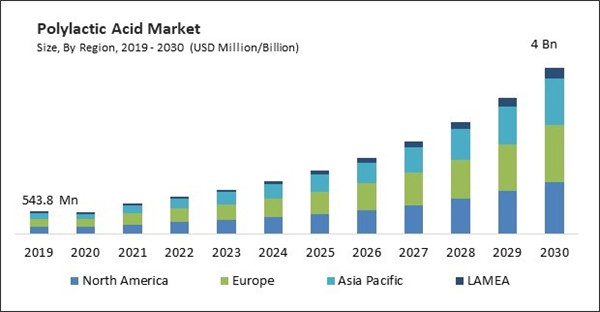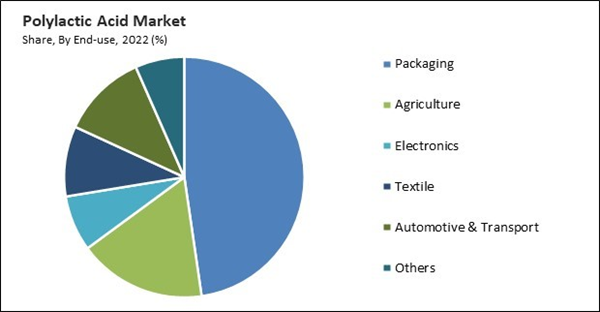The Global Polylactic Acid Market size is expected to reach $4 billion by 2030, rising at a market growth of 20.8% CAGR during the forecast period. In the year 2022, the market attained a volume of 2,86,717.1 Tonnes, experiencing a growth of 18.1% (2019-2022).
The automotive industry faces pressure to decrease vehicle weight to enhance fuel efficiency and mitigate greenhouse gas emissions. PLA is attractive to automakers because it is lightweight compared to traditional plastics and can help achieve weight reduction goals, ultimately enhancing fuel efficiency. Thereby, the automotive & transport sector would acquire 1/5th share of the market by 2030. PLA's biodegradability aligns with the automotive industry's commitment to sustainability and environmental responsibility. By using PLA-based components, automakers can reduce the environmental impact of their vehicles, particularly in interior and non-structural parts. These aspects will help in the expansion of the segment in the future. Some of the factors impacting the market are increased awareness of environmental issues, ongoing research and development to improve polylactic acid properties, and high production cost of polylactic acid.
The rising environmental consciousness among consumers, businesses, and governments has led to an increased demand for eco-friendly materials. PLA, being a biodegradable and renewable biopolymer, aligns with this demand. As a result, the market experiences growing interest and demand across various industries, such as packaging, textiles, medical, and automotive. As more industries and applications recognize the benefits of PLA in reducing plastic waste and environmental impact, the market's reach broadens. This expansion opens up new opportunities for manufacturers and suppliers, creating a more competitive and dynamic marketplace. Additionally, by enhancing PLA's mechanical and thermal properties, researchers and manufacturers have expanded its range of applications. As PLA becomes more versatile, it can be utilized in a broader spectrum of industries and products, including those that require specific mechanical and thermal characteristics. The improvements in PLA's properties have made it a more attractive alternative to traditional petroleum-based plastics. PLA can offer similar or even better performance in certain applications, such as packaging, textiles, and 3D printing. This increased competitiveness with traditional plastics drives higher adoption of PLA in industries where sustainability and biodegradability are valued. These factors pose lucrative growth prospects for the market.
However, many industries and consumers are highly price-sensitive. In markets where cost is a primary consideration, the higher production cost of PLA can make it less competitive. Potential users may choose traditional plastics based on cost considerations, negatively impacting the market's growth and adoption. PLA competes with established, low-cost plastics like polyethylene (PE) and polypropylene (PP) in various applications, particularly packaging and disposable products. The cost disadvantage can limit market share and hinder its ability to compete effectively in these price-sensitive markets.
The market research report covers the analysis of key stake holders of the market. Key companies profiled in the report include Toray Industries, Inc., NatureWorks LLC, Futerro SA (GALACTIC group), COFCO Corporation, Shanghai Tong-jie-liang Biomaterials Co., LTD., Zhejiang Hisun Biomaterials Co., Ltd., BASF SE, Evonik Industries AG (RAG-Stiftung), Mitsubishi Chemical Holdings Corporation, and DANIMER SCIENTIFIC, INC.
The automotive industry faces pressure to decrease vehicle weight to enhance fuel efficiency and mitigate greenhouse gas emissions. PLA is attractive to automakers because it is lightweight compared to traditional plastics and can help achieve weight reduction goals, ultimately enhancing fuel efficiency. Thereby, the automotive & transport sector would acquire 1/5th share of the market by 2030. PLA's biodegradability aligns with the automotive industry's commitment to sustainability and environmental responsibility. By using PLA-based components, automakers can reduce the environmental impact of their vehicles, particularly in interior and non-structural parts. These aspects will help in the expansion of the segment in the future. Some of the factors impacting the market are increased awareness of environmental issues, ongoing research and development to improve polylactic acid properties, and high production cost of polylactic acid.
The rising environmental consciousness among consumers, businesses, and governments has led to an increased demand for eco-friendly materials. PLA, being a biodegradable and renewable biopolymer, aligns with this demand. As a result, the market experiences growing interest and demand across various industries, such as packaging, textiles, medical, and automotive. As more industries and applications recognize the benefits of PLA in reducing plastic waste and environmental impact, the market's reach broadens. This expansion opens up new opportunities for manufacturers and suppliers, creating a more competitive and dynamic marketplace. Additionally, by enhancing PLA's mechanical and thermal properties, researchers and manufacturers have expanded its range of applications. As PLA becomes more versatile, it can be utilized in a broader spectrum of industries and products, including those that require specific mechanical and thermal characteristics. The improvements in PLA's properties have made it a more attractive alternative to traditional petroleum-based plastics. PLA can offer similar or even better performance in certain applications, such as packaging, textiles, and 3D printing. This increased competitiveness with traditional plastics drives higher adoption of PLA in industries where sustainability and biodegradability are valued. These factors pose lucrative growth prospects for the market.
However, many industries and consumers are highly price-sensitive. In markets where cost is a primary consideration, the higher production cost of PLA can make it less competitive. Potential users may choose traditional plastics based on cost considerations, negatively impacting the market's growth and adoption. PLA competes with established, low-cost plastics like polyethylene (PE) and polypropylene (PP) in various applications, particularly packaging and disposable products. The cost disadvantage can limit market share and hinder its ability to compete effectively in these price-sensitive markets.
End-use Outlook
Based on end-use, the market is divided into packaging, agriculture, automotive & transport, electronics, textiles, and others. The packaging segment recorded the maximum revenue share in the market in 2022. One of the primary drivers of PLA's growth in the packaging sector is the increasing consumer demand for sustainable and eco-friendly packaging materials. Consumers are becoming more conscious of the environmental impact of packaging, leading to a preference for materials like PLA, which is biodegradable and derived from renewable resources. Governments and regulatory bodies in many regions have introduced policies and regulations to reduce the use of single-use plastics and promote the adoption of biodegradable packaging materials. This has created a favorable environment for PLA, as it aligns with these sustainability goals. These factors are expected to boost the demand in the segment.Regional Outlook
By region, the market is segmented into North America, Europe, Asia Pacific, and LAMEA. In 2022, the Europe segment acquired the highest revenue share in the market. The packaging industry in Europe has shown a significant interest in PLA as a sustainable alternative to traditional plastics. The use of PLA in food packaging, beverage containers, and other consumer goods is on the rise. The ability of PLA to provide good barrier properties against oxygen and moisture makes it particularly suitable for these applications. The European fashion and textiles industry has explored PLA-based fabrics as a sustainable alternative to traditional synthetic textiles. PLA's properties, such as breathability and biodegradability, align with the growing demand for sustainable and bio-based fashion. These factors are expected to boost the demand in the segment.The market research report covers the analysis of key stake holders of the market. Key companies profiled in the report include Toray Industries, Inc., NatureWorks LLC, Futerro SA (GALACTIC group), COFCO Corporation, Shanghai Tong-jie-liang Biomaterials Co., LTD., Zhejiang Hisun Biomaterials Co., Ltd., BASF SE, Evonik Industries AG (RAG-Stiftung), Mitsubishi Chemical Holdings Corporation, and DANIMER SCIENTIFIC, INC.
Scope of the Study
Market Segments Covered in the Report:
By End-use (Volume, Tonnes, USD Million, 2019-2030)- Packaging
- Agriculture
- Electronics
- Textile
- Automotive & Transport
- Others
- North America
- US
- Canada
- Mexico
- Rest of North America- Europe
- Germany
- UK
- France
- Russia
- Spain
- Italy
- Rest of Europe- Asia Pacific
- China
- Japan
- India
- South Korea
- Singapore
- Malaysia
- Rest of Asia Pacific- LAMEA
- Brazil
- Argentina
- UAE
- Saudi Arabia
- South Africa
- Nigeria
- Rest of LAMEA
Key Market Players
List of Companies Profiled in the Report:
- Toray Industries, Inc.
- NatureWorks LLC
- Futerro SA (GALACTIC group)
- COFCO Corporation
- Shanghai Tong-jie-liang Biomaterials Co., LTD.
- Zhejiang Hisun Biomaterials Co., Ltd.
- BASF SE
- Evonik Industries AG (RAG-Stiftung)
- Mitsubishi Chemical Holdings Corporation
- DANIMER SCIENTIFIC, INC.
Unique Offerings
- Exhaustive coverage
- The highest number of Market tables and figures
- Subscription-based model available
- Guaranteed best price
- Assured post sales research support with 10% customization free
Table of Contents
Chapter 1. Market Scope & Methodology
Chapter 2. Market At a Glance
Chapter 3. Market Overview
Chapter 4. Global Polylactic Acid Market by End-use
Chapter 5. Global Polylactic Acid Market by Region
Chapter 6. Company Profiles
Companies Mentioned
- Toray Industries, Inc.
- NatureWorks LLC
- Futerro SA (GALACTIC group)
- COFCO Corporation
- Shanghai Tong-jie-liang Biomaterials Co., LTD.
- Zhejiang Hisun Biomaterials Co., Ltd.
- BASF SE
- Evonik Industries AG (RAG-Stiftung)
- Mitsubishi Chemical Holdings Corporation
- DANIMER SCIENTIFIC, INC.
Methodology

LOADING...










